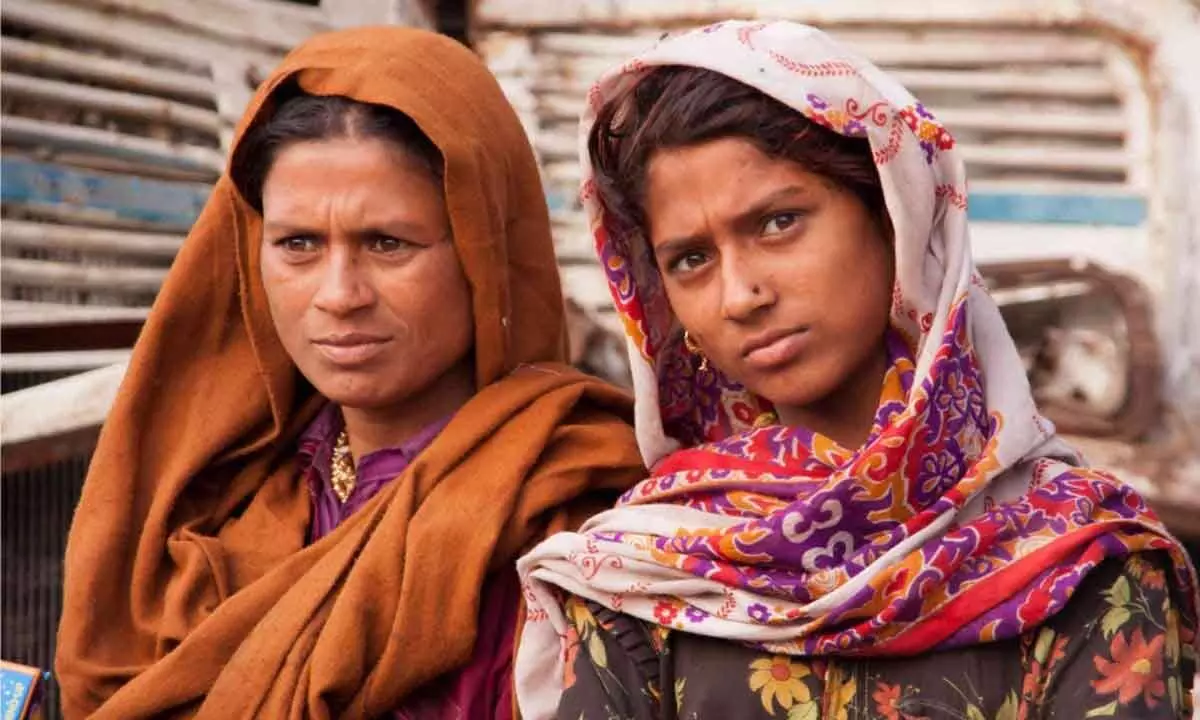Fighting for survival: Climate change pushes women to limits of endurance

Experiencing one of its hottest summers, the country has recorded more than 40,000 suspected heat stroke cases and more than 100 heat-related deaths. According to IMD, around 40 per cent of the country recorded double the number of heatwave days than it usually does in the April to June period. Excessive heat leads to exhaustion, dehydration, and an increased risk of urinary infections. Women workers in tea estates, street vendors, and safai sathis are exposed to direct sunlight, affecting their productivity and health. Home-based workers also see their income impacted as they juggle household tasks and work, leading to a loss of income
“It’s all about survival,” says Majida Begum, her face wreathed in sweat as she sifts through waste in Delhi’s Seemapuri area, echoing as it were the everyday struggles of millions of women in India facing the brunt of the twin crises of heat and humidity. As climate change tightens its grip over the globe, a study by the UN’s Food and Agriculture Organization shows that on average, female-headed households in rural areas lose 8 per cent more of their income due to heat stress compared to male-headed households.
While men have moved on to secondary and tertiary sectors due to improved skills, women remain in unorganised sectors characterised by repetitive and labour-intensive tasks, explained Seema Bhaskaran, gender lead at the NGO Transform Rural India,
And Majida is living testament of it all. Spending hours beneath a makeshift shelter of four slender sticks and a torn bedsheet, the asphalt radiating heat from the sharp sun and high humidity, as she does her day’s job, the 65-year-old ragpicker is weather-beaten and old beyond her years.
With beads of sweat tracing paths down her lined face, she walks to a community water tank located around a hundred metres away. She ducks her head beneath the tap, letting the water cascade over her. Refreshed, for the moment, she returns to her sorting in the oppressive heat. “It’s about survival,” she explained between tasks. “We drench ourselves with water every hour just to keep going.”
This ritual is a necessity for Majida and others like her amid the unbearable conditions of their work – the absence of sufficient drinking water, toilets, sunshades and prolonged exposure to the elements. Majida’s husband, aged 70 and immobile, relies entirely on her earnings. Their estranged son offers no support.
On good days, she earns Rs 250 for separating recyclables from the waste stream, but when illness strikes and she cannot work, they are left with virtually nothing. “Whether we eat at night depends on whether I work during the day,” Majida said.
“This is the hottest summer I have experienced in many years. The heat made me unwell, and I could not work for 15 days. I am a heart patient, but I cannot afford to stay at home,” she said. In urban agglomerations and in rural India, climate change-fuelled extreme heat is making women from marginalized communities and poor households more vulnerable to economic and health loses.
Women already earn 20 per cent less than men on average, according to the International Labour Organization, and this gap is further widened due to heat waves. In an unprecedented summer, where the heat index has crossed 50 degrees Celsius in many places, the stories are many.
Basanti Nag, 28, from Kokawada village in Chhattisgarh’s Sukma district, said the summer this year caused nausea and lethargy never experienced before, and the problem was amplified for women who had to travel longer distances to fetch water.
In Dantewada district, Mangaldai’s family of three depends on the labour-intensive task of collecting and selling mahua flowers in the peak summer months. “This year, there has been less mahua work than ever before, with almost half the amount compared to previous years. As a result, my income will also be halved,” Mangaldai said.
Mahua is a major non-timber forest produce and a primary source of income for many in the country’s tribal areas. “In agriculture, women perform back-breaking operations like sowing, transplanting, and harvesting without any mechanization.
Excessive heat leads to exhaustion, dehydration, and an increased risk of urinary infections. Women workers in tea estates, street vendors, and safai sathis are exposed to direct sunlight, affecting their productivity and health. Home-based workers also see their income impacted as they juggle household tasks and work, leading to a loss of income,” Bhaskar told PTI.
For women, sustenance tasks like fetching water, fuelwood, and fodder take longer in extreme heat. Pregnant women face risks of stillbirth. Care work increases with rising illnesses, leading to further loss of employment and economic participation, she added.
A survey conducted by Greenpeace India and the National Hawkers’ Federation revealed that seven out of eight women street vendors in Delhi experienced high blood pressure during heat waves in April and May, while women in the middle age group raised concerns about delays in their menstrual cycles due to the extreme heat. All the women who participated in the survey mentioned that sleeplessness during the night is common due to increased heat, and this results in exhaustion throughout the day.
Back in Delhi’s Seelampur, 30-year-old Saira has shifted from waste segregation to house cleaning because the punishing heat impacted her income. “I would often fall ill during summers because of the heat. There was no steady income even after working long hours among the mounds of trash emanating intolerable stench,” Saira, who is raising her daughters aged six and 11 alone after the in-laws “rejected” her, told PTI.
The heat is making their already difficult daily life worse. Amid the lack of cooling in her cramped single room home with no windows, the children often fall ill. “My employers have already warned me against taking frequent leaves. But since I am the only caregiver for my children, I have to take leave from work in such situations,” she said.
In the city’s Sundernagari slum, Radha Koli faces a similar predicament. She works as a domestic help to feed her family of five, including three daughters and her husband. The relentless heat made her youngest daughter, 10, sick forcing
Radha to stay home for a few days which resulted in a pay cut. “We are barely able to afford food and shelter with the Rs 3,500 I earn working at two houses. We do our best to keep illness away, but this heat is taking a toll on all poor families,” Koli said.
Experiencing one of its hottest summers, the country has recorded more than 40,000 suspected heat stroke cases and more than 100 heat-related deaths. According to IMD, around 40 per cent of the country recorded double the number of heatwave days than it usually does in the April to June period.
In Delhi, which logged 40 consecutive days of temperatures above 40 degrees Celsius since May 13, there have been around 60 heat-related deaths this year, according to media reports. It’s not just Delhi of course. Heatstroke and jaundice kept Birasmuni Solanki, a vegetable vendor in the Jharkhand capital Ranchi confined to her single-room home with a small ceiling fan hanging from the tin roof.
The tin roof turns the room into an oven, making temperatures unbearable. Everyone in her family, including her daughter, husband, and mother-in-law, suffered from heatstroke this year. Since her husband, a construction worker, works only occasionally, she is the primary breadwinner in the family. On days she was unwell, Solanki said the family struggled to put food on their plates, forcing them to borrow money from relatives and neighbours.
Annu Mishra kept her modest food stall shut as temperatures in Bhubaneswar, Odisha, remained above 40 degrees
Celsius for 17 consecutive days in April. This streak was the longest since 1969, severely impacting health and livelihoods. “The crippling heat made it extremely difficult to stand near the gas stove,” said 51-year-old Mishra, noting that the only time her food stall had remained shut for such a long duration was during Cyclone Fani in 2019.
The scorching summer sun is slowly giving way to sullen, cloudy skies. But temperatures are still high and the humidity has made things worse in many places. The promise of rain – and hopefully no floods – is keeping the women going.



















